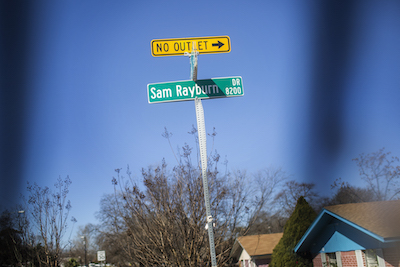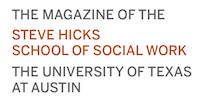By David Springer
Broderick James, better known as “The Running Man,” can be found at the corner of Rundberg Lane and Lamar Blvd., spreading optimism and hope through the power of dance. He has been an informal promoter of community engagement for an improved Rundberg area for over seven years, and he dreams of a better Rundberg for the next generation. According to James, “the dream is when we bring this community together.”

That dream is shared by The University of Texas at Austin’s Austin School of Social Work, Austin Police Department (APD), social service providers, and the residents and families that live in Rundberg. Today, the north-Austin Rundberg neighborhood struggles with high crime rates, prostitution, poverty, and exposed drug use. Kids feel pressure to join gangs and too often fall into the school-to-prison pipeline. Criminal activity coupled with poverty, disinvestment, and unemployment within the neighborhood discourage redevelopment and economic growth.
We have partnered with the APD team, led by Commander Donald Baker, and community leaders and stakeholders to Restore Rundberg, a project that aims to “improve the quality of life, health, safety, education, and well-being of individuals living and working in the Rundberg neighborhood.” Sustainable and innovative community engagement is at the core of what we’re trying to do so that we have a multigenerational impact.
Initial funding in the form of a 3-year $1 million Department of Justice grant – part of the Obama Administration’s Neighborhood Revitalization Initiative – will allow Restore Rundberg to address crime and improve public safety, which is a prerequisite for sustainable investment. APD reached out to us to help identify innovative crime interventions that would lead to long-term solutions. I have been working with a team from our school – professors Yessenia Castro, Noel Landuyt, Michael Lauderdale, Cal Streeter, Ahmed Whitt, and graduate students — to produce a comprehensive plan. We are recommending strategies that focus on addressing persistent crime, physical and social disorder, and youth issues by increasing community engagement and improving the community’s relationship with police. We hope to see at least a 5 percent decrease in violent and property crimes by 2016.
The project attempts to be mindful of its existing residents, hoping to identify strategies that do not simply shift crime to other neighborhoods or invite gentrification. Strategies to revitalize Rundberg focus on five overarching areas:
- persistent crime
- physical and social disorder
- community engagement
- the community’s relationship with police
- at-risk youth.
Working with APD and analyzing crime data from the last seven years, we have identified areas where crime is tightly concentrated, or “crime hot spots.” Three of the identified hot spots account for 21 percent of crime in the area and 12 percent of crime citywide. This suggests that we can identify and deal with a large proportion of crime problems by focusing on a very small number of places. The three identified hot spots look and feel unsafe: They are backed by vacant lots and open fields, and there is persistent drug and prostitution activity, gang activity, litter and garbage, oddly placed pay phones, drug paraphernalia, poor parking conditions, graffiti, and loitering.
We know that we can’t arrest our way out of this situation. We are working with APD to adopt a community policing strategy for the area’s crime hot spots, meaning that police will enhance their visibility and community involvement through the use of increased foot and bike patrols. We are also working with APD to deploy officers in a way that builds relationships with the immigrant community. We want residents to get to know Austin police officers and see them as allies toward creating a safer and stronger community. In this spirit, APD is following our recommendation to hire a full-time neighborhood engagement specialist to assist with this critical effort.
As expected, the fastest growing population in the Rundberg area is the Hispanic population, with concentrated growth in young children between the ages of birth to 9 years. Many youth in the area are considered at-risk given their socio-economic status, the presence of criminal and gang activity in the area, poor school performance and high dropout rates. Restore Rundberg calls for an overarching focus on youth development to decrease risk factors and enhance protective factors through a range of community- and school-based programs, youth mentoring, and youth gang prevention and intervention programs.
We hope that our efforts can gain some traction in restoring the neighborhood and reducing crime over the next two years. But all of us involved in this initiative recognize that this is a long-term effort. Perhaps the Running Man has captured it best – “I’m gonna sit down on that corner until this community changes.”
David Springer, Ph.D., is a University Distinguished Teaching Professor at The University of Texas at Austin’s School of Social Work
